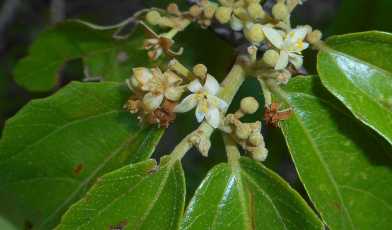Why this species?
With knowledge of only six individual Tetralix nipensis trees at the start of 2016, this rare Cuban species became an immediate conservation priority. At home near streams running through Cuba’s Sierra de Nipe mountain range, T. nipensis grows sparsely amongst other small trees and a rich tapestry of herbs, shrubs, and ferns. Tetralix nipensis and 93 other threatened plants thrive in this elusive “wet charrascal” habitat.
Unfortunately, the conditions are also suitable for commercial forestry and intensive agriculture because of the moderately rich soils and frequent rainfall. The last pockets of remaining habitat for this species are therefore under threat from land-use change for forestry, agriculture and open-cast mining. These threats are increasingly encroaching upon the remaining forest. Further development is only likely to worsen this pressure unless a compromise between conservation and economic growth can be reached.
Although there are currently 160 threatened tree species in Cuba, T. nipensis’ conservation is exceptionally urgent due to its tiny, endemic population. This small population makes T. nipensis more susceptible to unpredictable threats like natural disasters. Furthermore, T. nipensis is an ideal umbrella species – by prioritising conservation efforts to safeguard its remaining population, countless other endemic Cuban species facing similar threats will receive protection.
Tetralix nipensis habitat. Credit: Jose L. Gomez/Planta!
What are we doing about it?
We are working with our Cuban NGO partner Planta! to better understand the threats facing T. nipensis and then eventually provide effective protection to its entire population. To achieve this we are supporting Planta! to undertake the following key steps:
- Planta! is conducting a series of surveys across the Sierra de Nipe mountain range to identify priority areas and key threats for T. nipensis. During these surveys, additional rare plants sharing the same habitat are being noted to maximise conservation impact.
- Based on the survey results, Planta! is liaising with local stakeholders to develop plans to increase the protection of T. nipensis and its habitat.
- Planta! is working with the local government to integrate the majority of the T. nipensis’ population into the Mensura-Pilotos National Park management. In parallel, we are also exploring the training that Park staff may need to effectively protect National Park species.
Charrascal habitat- this is where a population of 111 adult T. nipensis trees were found in 2016. Credit: Planta!
Key achievements
Survey work has already revealed two new populations of T. nipensis consisting of 362 new individuals. While this is fantastic news for the future conservation of the species, 98% of the individuals are currently growing outside of protected areas. This means the population is still very vulnerable to being decimated by agriculture, forestry and mining development in the area.
Contact details
For more information on this project, please contact [email protected]
